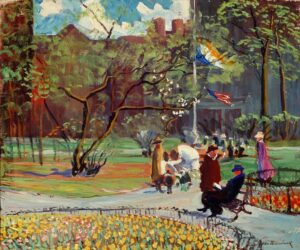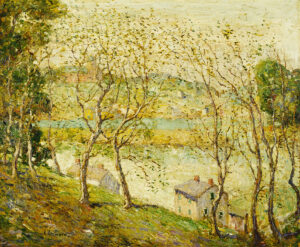Welcome to April and to your Convivio Book of Days Calendar for April! It is late, but hey, let’s embrace that belatedness that is part of what makes Convivio Bookworks, well… Convivio Bookworks. Perhaps someday, when I can devote all my time to this venture, things will be more timely… but I suspect you’d miss the old version of me who is constantly running late. Efficiency is very alluring but there is a certain charm to someone who is constantly running just a step or two ahead of (or behind, in my case) the clock. You’d miss that if I suddenly became efficient.
My only regret about this month’s belatedness is I missed reminding you (or warning you, as such the case may be) of All Fools’ Day on the First of the Month. If you were successful with a great trick, or if you fell victim to a trick that was particularly brilliant, I’d love to hear about it (comments below, please). Seth and I both got through the day un-tricked this year, but I do love a nice subtle trick (like gluing shut the cap on the toothpaste tube, or gluing the toilet paper to itself so Seth can’t find the end). But this year, what with Easter just the day before, All Fools’ Day was practically done before I even remembered what day it was.
Anyway, I hope you enjoy this month’s calendar. Our focus this month is the day (or night, actually) that closes the month. It is a night not much celebrated here in the States, but me, ever the champion of the underdog, I will be celebrating (as will Seth, by default) and if you’d care to join us, well, it’s a wonderful night that is the opposite spoke in the Wheel of the Year from Hallowe’en: It is Walpurgis Night, or the Eve of May, or St. Walpurga’s Eve. May Day comes on the First of May, as does St. Walpurga’s Day, and it is the day, traditionally, when we shift toward welcoming summer. Not by the almanac, mind you… but by traditional reckoning of time, and I am a big fan of reckoning time in a traditional manner.
Our cover star this month is a 1918 oil painting by Louise Upton Brumback called “May Day, Boston” [Public domain, via Wikimedia Commons].
SHOP OUR SPRING SALE!
It’s still spring, of course, and at our online catalog right now, you may use discount code BLOSSOM to save $10 on your $85 purchase, plus get free domestic shipping, too. That’s a total savings of $19.50. Spend less than $85 and our flat rate shipping fee of $9.50 applies. CLICK HERE to shop; you know we appreciate your support immensely.
COME SEE OUR NEW SHOP!
We make small improvements to our new shop every week. Currently, we’re looking at building a staircase to the loft, which would be so much more elegant than that extension ladder we’ve been using so far. Our Open House Weekend in mid-March was grand, and I was so happy to see so many old friends. We’ll plan a proper Grand Opening as soon as we feel the time is right. I’m thinking May, or perhaps it’ll be around Old Midsummer in late June. Rest assured, I’ll tell you about it here and on our Instagram and Facebook pages (@conviviobookworks). We don’t have regular hours currently, but until we do, if you’d like to come shop or just see the place (or us), we welcome you to come visit by appointment. Email us to schedule a time. The new shop is located at 1110 North G Street, Suite D, in Lake Worth Beach, Florida 33460.


